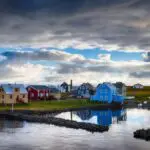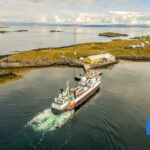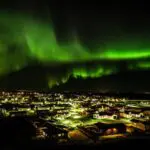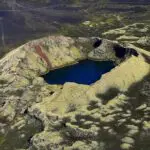Despite Reykjavik’s long history, there aren’t many very old houses in downtown Reykjavik. The oldest buildings are mainly from the mid-18th century. The oldest building in Iceland is Keldur in Rangárvellir in South Iceland. It is a turf and timber house, and parts of it are believed to be from the 11th century.
The oldest house in Reykjavik is Viðey Island house, built in 1750-1752, while the oldest in downtown Reykjavik is Aðalstræti 10, built in 1762.
But because our houses don’t have as long a history as some other houses in Europe, it doesn’t mean they are without history! We would very much like to teach it to you, so we made a fun little self-walking tour for you, where you can walk around downtown Reykjavík, look at the houses and learn a little bit about them.
Austurstræti 4 – Thorvaldsens Bazar
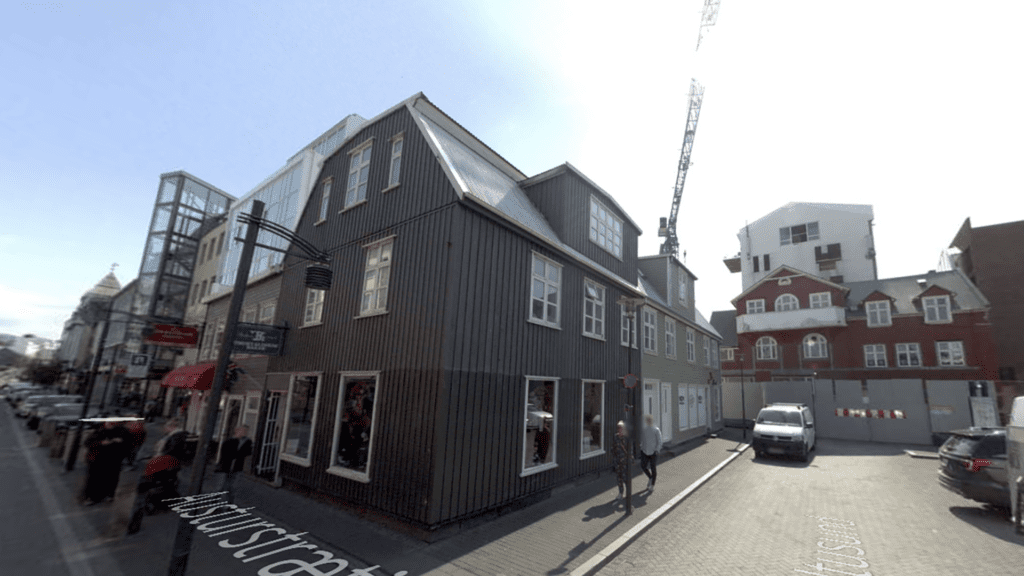
The first house on the plot was built in 1800, and it was also the first house built in Austurstræti. Shops and a restaurant were in the house, but between 1807-1820, it housed the Supreme Court. Then after that, it was used as a commercial and residential building.
The house was demolished in 1887, and a new house was built in its place, with its gable facing Austurstræti. Initially, the house was considered part of Vallarstræti (which runs parallel to it), and then it was part of Veltusund (the small street to the right of the house).
Then in 1905, Iceland’s oldest women’s association Thorvaldsen’s Association, bought the building, and their shop Thorvaldsen’s Bazaar, which is still open, opened in 1907.
First Women’s Association in Iceland
The association was founded in 1875 after a group of women got together to decorate Austurvöllur when a statue of half-Icelandic sculptor Bertel Thorvaldsen was to be unveiled there (the statue is now in Hljómskálagarður).
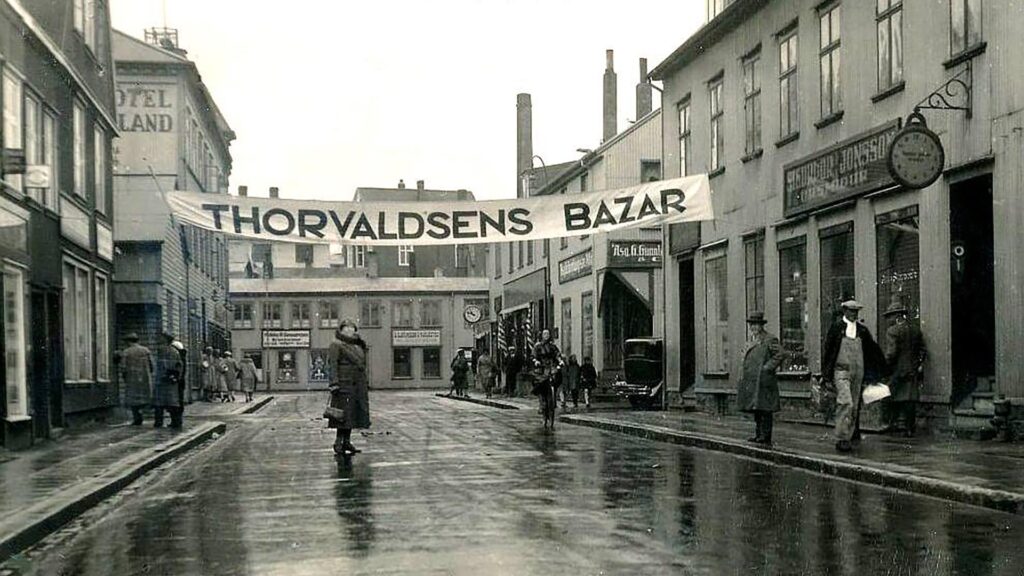
One of the association’s first projects was to sew clothes they gave poor people for Christmas. They raised money by holding bazaars and tombolas and even putting on plays. In 1876, they held the first Christmas ball for poor children. They also decided to teach handicrafts to those who did not have a chance to go to school. So, they taught girls between the ages of 7 and 17 how to knit and sew. This continued until 190,4 when it became a part of regular school activities. In addition, they had another school for older girls and women on Sundays, where they taught theoretical studies.
Laundry Women Got Help
If this wasn’t enough, they also gave the Icelandic laundry women a Pool House in Laugardalur. Laugardalur, which translates as Pool Valley, was where people, mostly women, washed clothes. Laugavegur, Reykjavik’s main shopping street, means Pool Road and was the main route to there. It was a “carriage passable” road which came especially handy for the washing ladies.
The laundry women washed clothes for others. They were usually poor and had to haul the clothes in baskets on their backs the 3 kilometers from downtown Reykjavik to the Washing Pools. They typically spend 10-15 hours washing clothes for others and then have to carry the wet clothes all the way back again.
In 1887, The Thorvaldsen’s Association gave those women a Washing-pool House, which could be used as facilities for the laundry women. The association gave it to Reykjavik, but with the obligation that the women workers would get a ride on carriages drawn by horses owned by the town.
Aðalstræti 12 – The Fish Market Restaurant
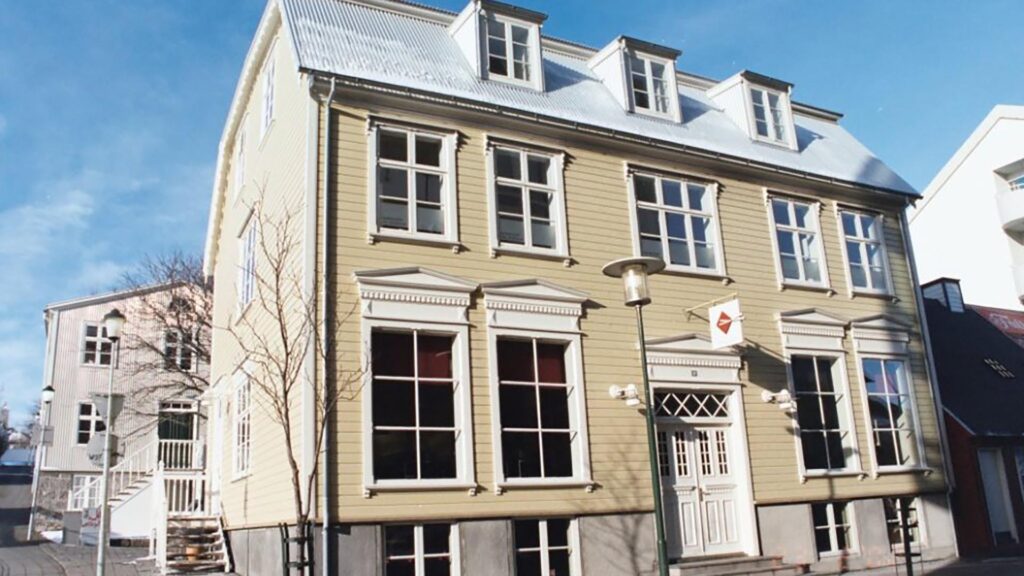
The house where The Fish Market restaurant is housed originally stood in Austurstræti, where you’ll find American Bar and Gyllti Kötturinn. In the late 1990s, the house was torn down, bit by bit, and moved to Aðalstræti 12, where it was rebuilt as it initially looked.
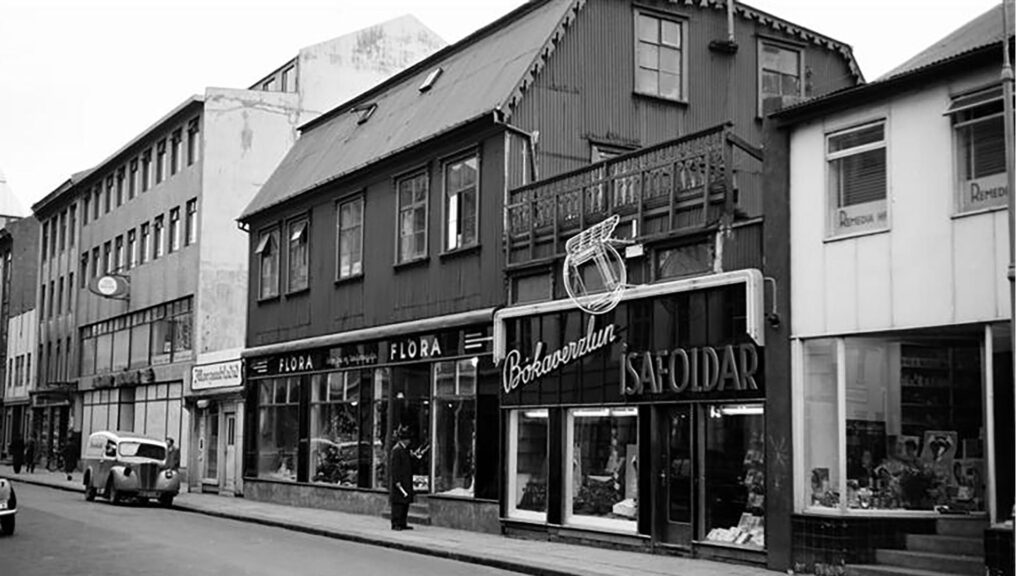
While it was in Austurstræti, it was called the “Ísafold” house as it housed a printing press and newspaper Ísafold. The house was built in 1886, and 13 years later, the owners had electricity installed. Morgunblaðið, one of Iceland’s largest newspapers, was established in 1913. For the first years, it was printed in the Ísafold printing press.
The printing press was moved from the house in 1942. Many different stores were in it before it was moved. Since then, the Fishmarket has been there the longest, but it opened in 2007.
Aðalstræti 10 – Reykjavik City Museum
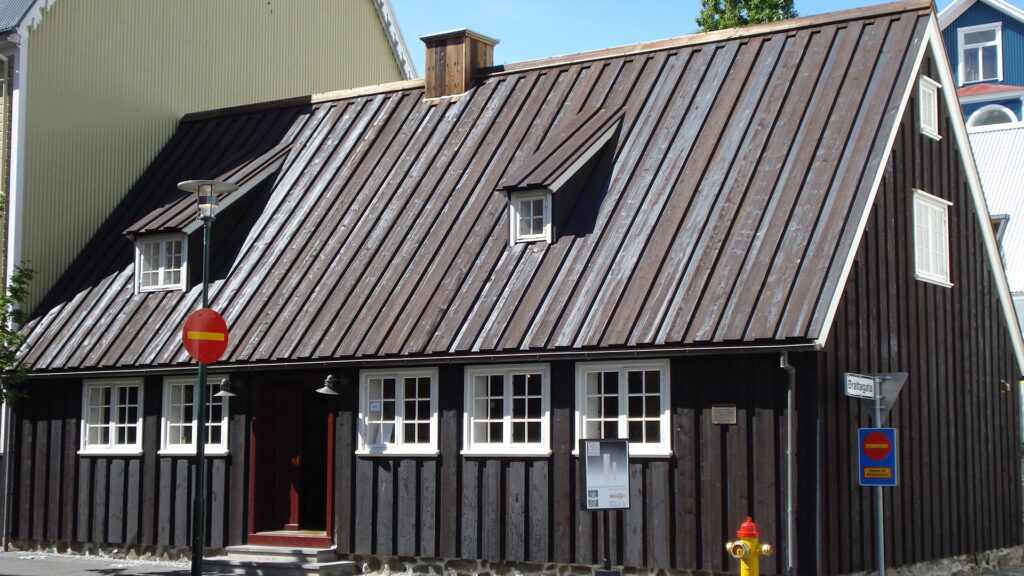
This is downtown Reykjavik’s oldest house. It was built in 1762 and was part of Skúli Magnússon’s Innréttingarnar company. The first Icelandic corporation which Skúli fought to establish. Iceland had been under a Danish trade monopoly for centuries, and Skúli was fed up with the lack of resources Icelanders had. So, the Innréttingar was opened as Skúli wanted to stimulate Icelandic production. Among the factories opened was a wool working factory.
Aðalstræti 10 has been the home of many famous Icelanders, among them was President Jón Sigurðsson’s brother. Jón was the leader of the 19th-century Icelandic independence movement. Despite not having lived a time when Iceland got home rule or independence, he’s still sometimes called President Jón. You can find his statue in front of the Parliamentary Building close by.
The building was also the bishop’s residence at the beginning of the 19th century. Still, since the 20th century, it has been chiefly used for various businesses. The convenience store Silli og Valdi (named after the owners) was there for decades and later houses various bars and restaurants. But today, it is part of the Settlement Exhibition and the Reykjavik City Museum. We recommend the Reykjavik City Card if you want to visit this museum (and others).
Vesturgata 2 – The Harbour House
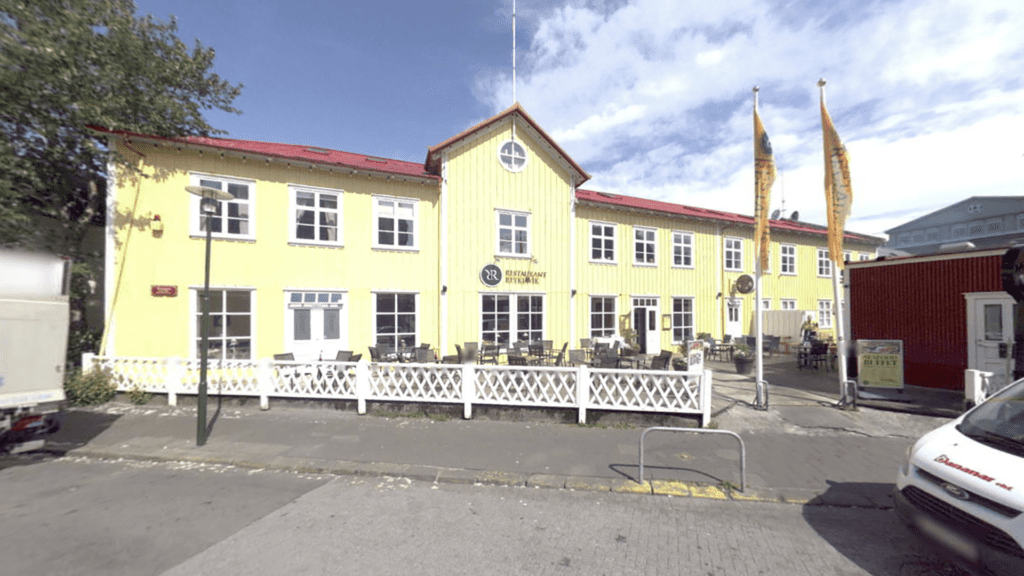
The house at Vesturgata 2 has been called “bryggjuhús” or “harbor house” since it was built in 1863. The name is because the original owner C. P. A. Koch had a dock built on the north side of the building. An underpass was made through the building to ensure access to the pier. This way, the building formed a sort of city gate for seafarers and others from the wharf into town.
The house wasn’t just named after the pier; the dock was also named after the owners. Around 1870, a man named Waldemar Fisher acquired the house. With that, the port was called Ficsherbryggja (Fischer pier), but he’s also the man the nearby Fischersund Street is named after.
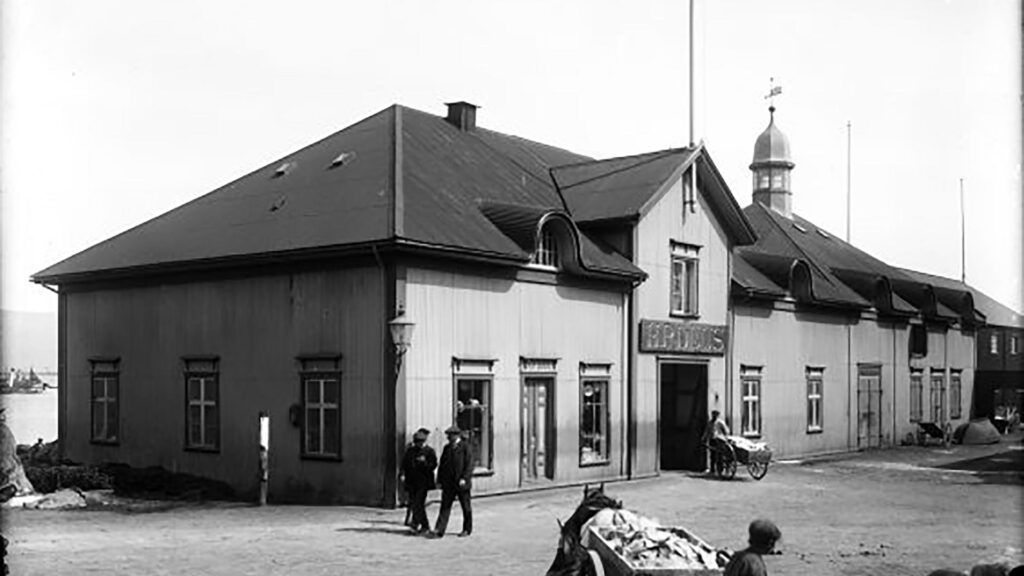
In 1904, the Duus store bought the house, and the pier’s name was changed to Duusbryggja.
Throughout the years, various companies have operated in the building. In the last few decades, there have been restaurants there.
Hafnarhúsið – Reykjavik Art Museum
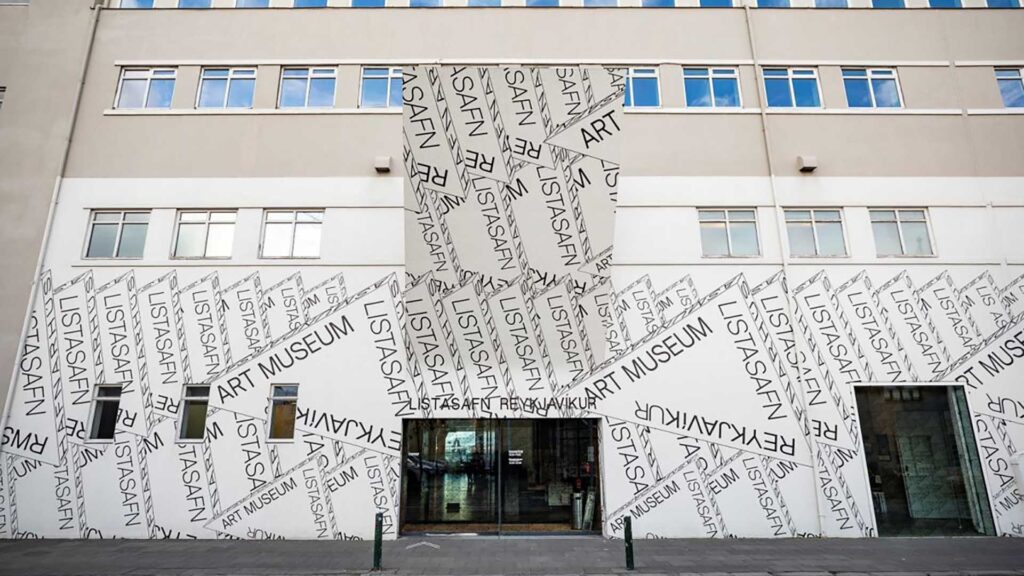
Hafnarhúsið stands by the old harbor in the oldest part of Reykjavík, just about where Fischer’s Pier once stood. In fact, when the house was renovated for the Reykjavik Art Museum, they decided to show where the old pier would have gone through the house.
The house was designed by architect Sigurður Guðmundsson, one of the pioneers of Icelandic architecture, in collaboration with Þórarinn Kristjánsson, harbor master in 1933-39 and its expansion in 1957-58. It was renovated to house the Reykjavík Art Museum from 1998-2000 by the architectural studio Studio Granda.
Hafnarhúsið houses artworks from the collection of the artist Erró. He has given the city of Reykjavík a large portion of his paintings and books. Additionally, various exhibitions of contemporary art are set up there.
Harpa Concert Hall and Convention Centre
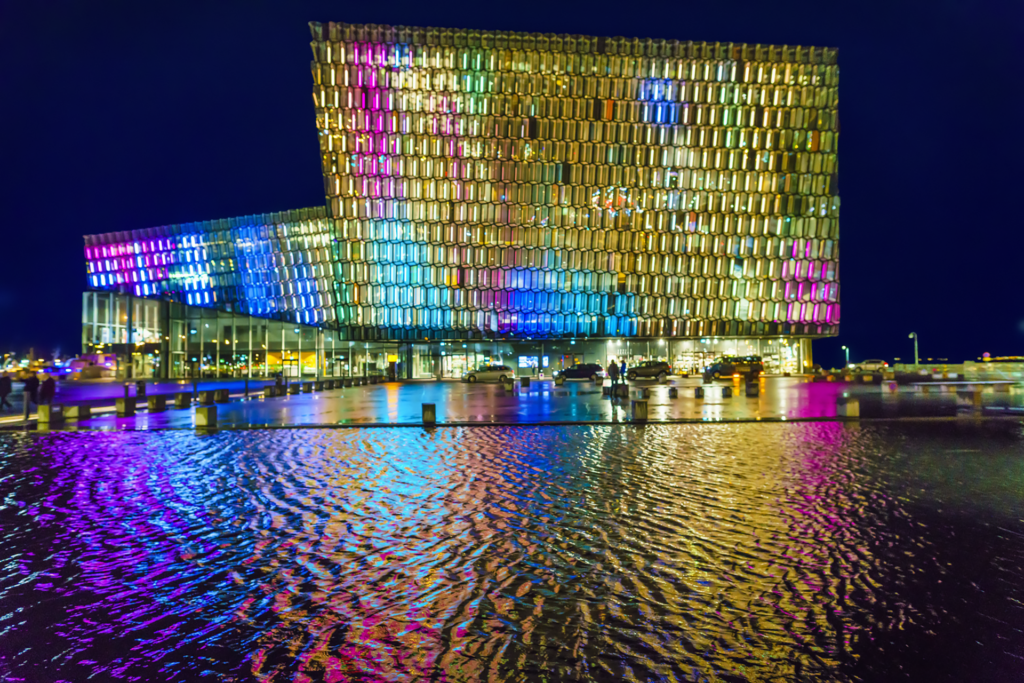
Despite its beauty, Harpa Concert Hall and Convention Centre was controversial at its inception. Iceland urgently needed an official concert hall for the Icelandic Symphonic Orchestra and the Icelandic Opera. Both institutions had been waiting for decades to get a suitable location. Finally, in the economic upswing around 2007, it was decided that it was time to build a concert hall.
A design competition was held, and a Danish architectural firm with Danish-Icelandic artist Ólafur Elíasson in the forefront won the competition. It was an ambitious endeavor as the shell of the house, so to speak, was supposed to – and does – be Ólafur’s artwork.
It took some time to figure out how to make it structurally sound, but it worked in the end.
Construction stopped in 2008
Then the financial crash happened in 2008 when the concert hall’s grounds were already built. As the Icelandic State had the biggest financial crash in economic history (per capita), all building was stopped. It was uncertain when or if it’d ever start again.
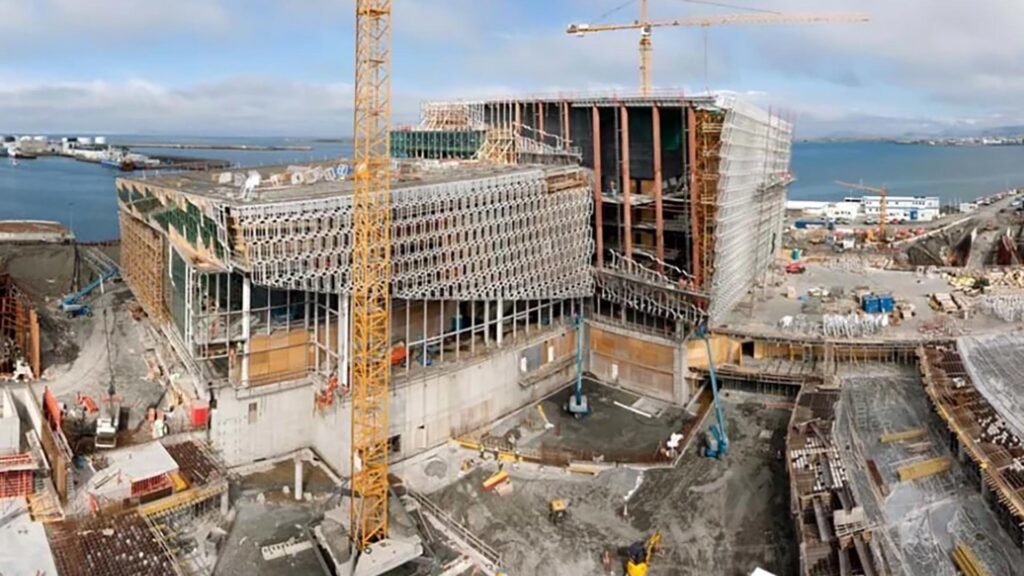
Then a few months later, it was decided it would be better to build the concert hall, despite the dire financial situation than let the concrete get ruined. And that’s when people started to protest. It was a joint project of the City of Reykjavik and the Icelandic State. People were furious that money was being spent on this when it could be spent on something else, like the healthcare system.
But today, pretty much everyone agrees that it is a beautiful and successful building, which has been confirmed many times judging by all the awards it has gotten.
The concert hall was originally a part of a major redevelopment of the area, dubbed the World Trade Center Reykjavik. It was supposed to include a 400-room hotel, luxury apartments, retail units, restaurants, a car park, and the new headquarters of the Icelandic bank Landsbankinn. In fact, at that time, the bank was privately owned, and this was a project the bank was funding.
However, in the financial crash, the bank was overtaken by the Icelandic State, which still owns it. It took some time for the redevelopment to begin again, but as of 2022, all these buildings and car parks have been built—even the new headquarters of Landsbankinn.
Iðnó – Reykjavik’s Main Meeting Place
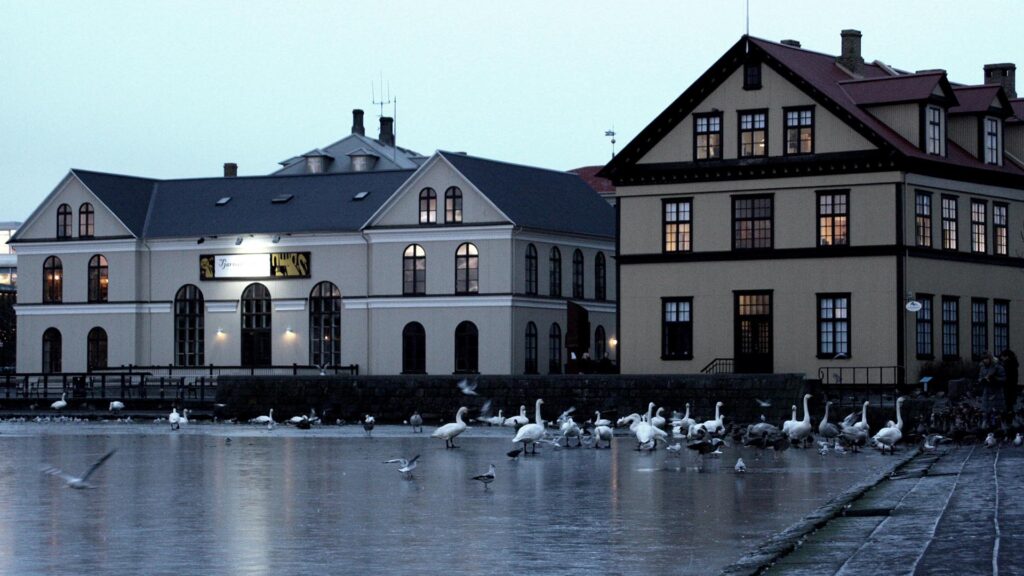
Iðnó, short for Iðnaðarmannaskálinn or The Craftsman Pavillion, was built on a landfill in the northeast corner of the lake in 1896. The Reykjavik Theatre company began its activities in Iðnó with the premiere of two Danish comedies on December 18, 1897. It was based in the building until 198,9 when it moved to the City Theatre next to Kringlan shopping mall.
Master carpenter Einar Pálsson designed and built the house. Einar also took care of building the agricultural society house next door.
The building was Reykjavik’s main meeting house. Iceland’s Home Rule was celebrated there on February 1, 1904, a cinema was set up in 1903, and when the King Christian X of Denmark came for an official visit in 1921, Iðnó was chosen as the place to hold a party for him.
The Agricultural House – Next Door to Iðnó
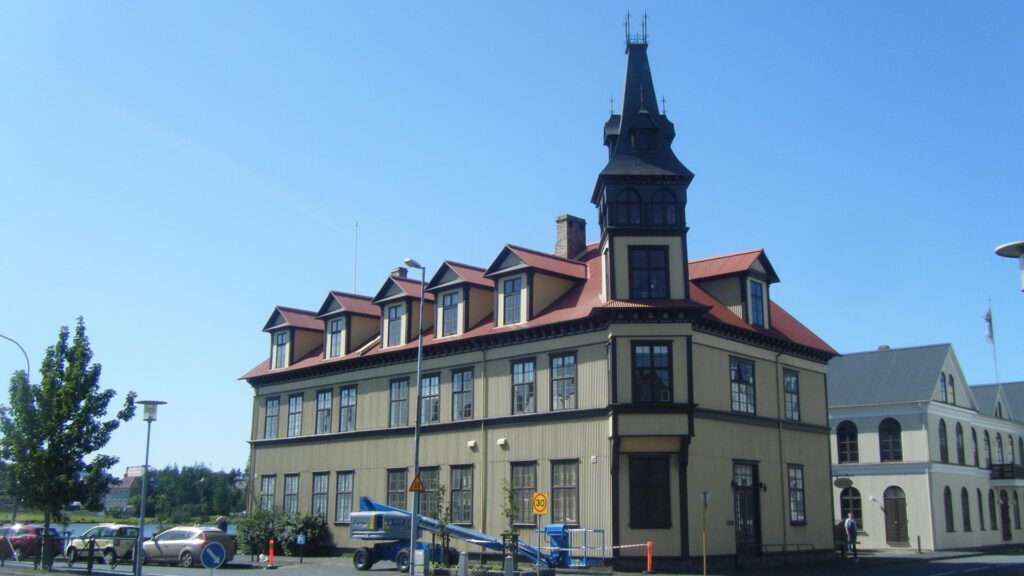
The Agricultural House or Lækjargata 14b is a wooden building next to Iðnó by the Pond in Reykjavík. The Icelandic Agricultural Society built the building in 1906, and its offices were at the south end of the house for decades.
By the middle of the century, it had been decided that the house should be demolished, so the Icelandic Agricultural Society moved its offices to Bændahöllin in 1964, where Hotel Saga was housed. Thankfully, nothing came of the plans to demolish the house. Later, in 1978, it was protected.
Reykjavik Cathedral
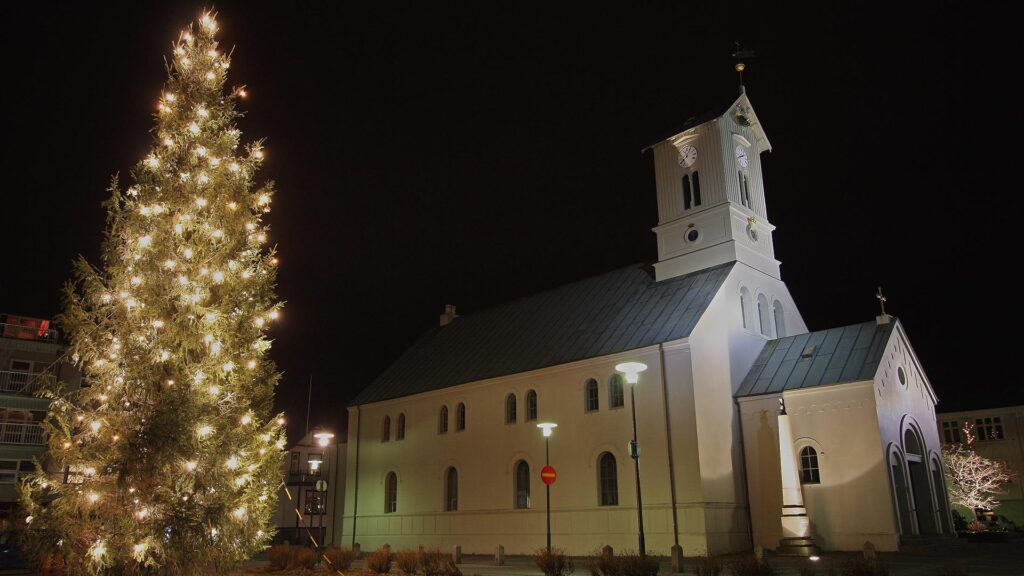
It was initially decided in 1785 that a cathedral should be erected in Reykjavik following a Southern region earthquake that caused quite a bit of damage to the church in Skálholt. The cathedral was to become the parish church of Reykvík and replace Vík Church, which had become too small and run down by then. It used to stand next to Austurvöllur, where there is now a hotel.
The first plan was to be built around the old Vík Church, but in 1787, when the work was supposed to start, it turned out that it was impossible for various reasons. Therefore, a new place was chosen not far away. It took a while to build it, and it wasn’t until 1796 that it was finally finished and inaugurated.
However, it was not a good build, and in 1815 it was not considered suitable for mass and was completely renovated in 1817. Two years later, a funeral home and a mortuary were built next to the church. Then in 1846-1848, the church was enlarged again, a project given to the Danish architect Laurits Albert Winstrup. Upkeep was nonexistent, and in 1878, just 30 years after its major renovations, it was again in complete disrepair. As a result, it was renovated again and re-consecrated the following year. Since then, it has been maintained reasonably regularly, and most recently, the tower was restored to its original state. Despite its many restorations, the base of it means it is one of the oldest houses in downtown Reykjavik.
The Parliament Building – Alþingi
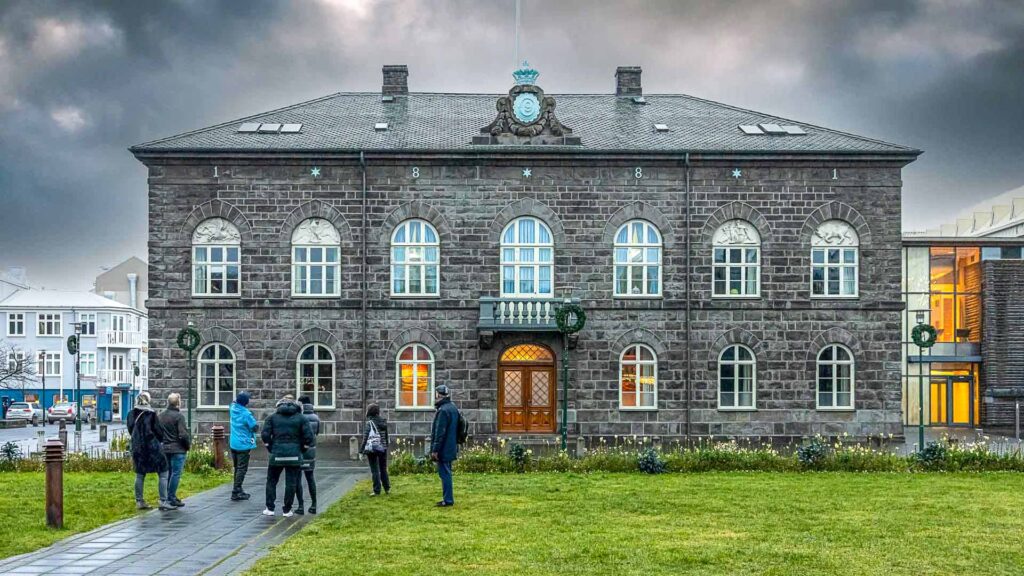
The Parliament Building stands by Austurvöllur and is one of the older houses in downtown Reykjavik. As the name implies, it is the seat of the Icelandic Parliament. The house was designed by Ferdinand Meldahl, director of the Academy of Fine Arts in Copenhagen. It was built in 1881, but its architect was F. Bald, a Danish man. The house was built from hewn Icelandic gray basalt (dolerite). Previously, in 1845-1881, Alþingi had worked in the old Latin School, which today houses the Reykjavík School of Education.
In 1880, work began constructing the Alþingi building at Kirkjustígur. At first, it had been assumed that the building would be built at Bakarastígur, where Bankastræti is now. Halldór Kr. Friðriksson, a headmaster, then sold his land at Kirkjustíginn for 2,500 ISK, which was considered an outrageous price in those days. His cabbage garden used to be where the House of Parliament was built.
During the construction of the house, as well as the prison house at Skólavörðustíg (built-in 1872), artisans from Reykjavík learned to cut and prepare stones from Reykjavik’s hills and build buildings.
Hótel Borg
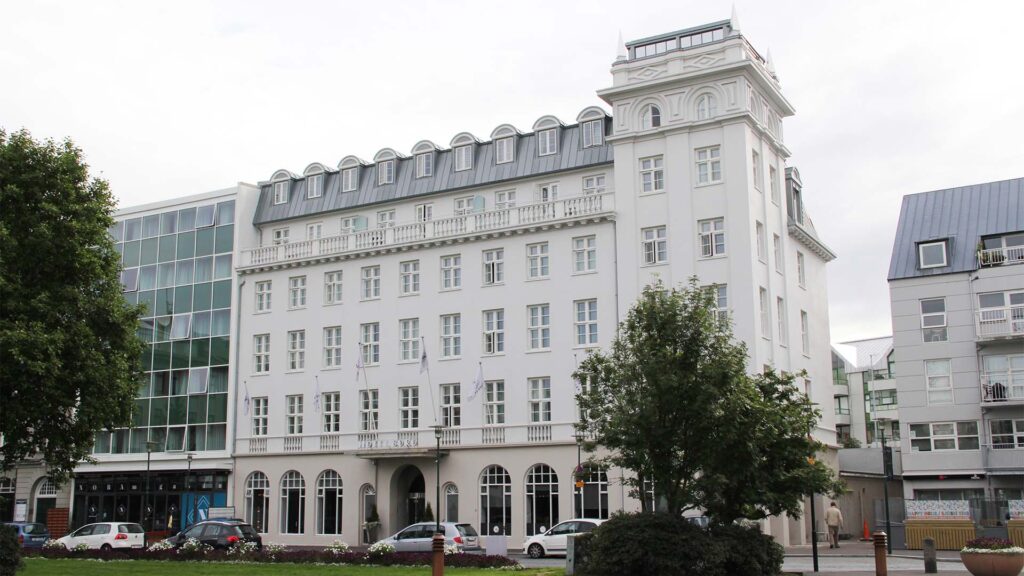
Guðjón Samúelsson designed Hótel Borg by Austurvöllur. The hotel was owned by wrestler Jóhannes Jósefsson and his wife Karólína Amalía Guðlaugsdóttir and opened in the spring of 1930, just before the 1000th anniversary of the Icelandic Parliament.
The house was occupied by the British during World War II. For a long time, the hotel was the only legal pub in the country and the center of entertainment and music. After the 1950s, options became more numerous.
There are, of course, plenty of other houses in downtown Reykjavik to talk about, and we will both add to this post and make a part two about the other side of Lækjargata. Stay tuned to learn about the Government Building, which used to be a prison, the Central Bank, and more.
Please signup HERE for our newsletter for more fun facts and information about Iceland!

